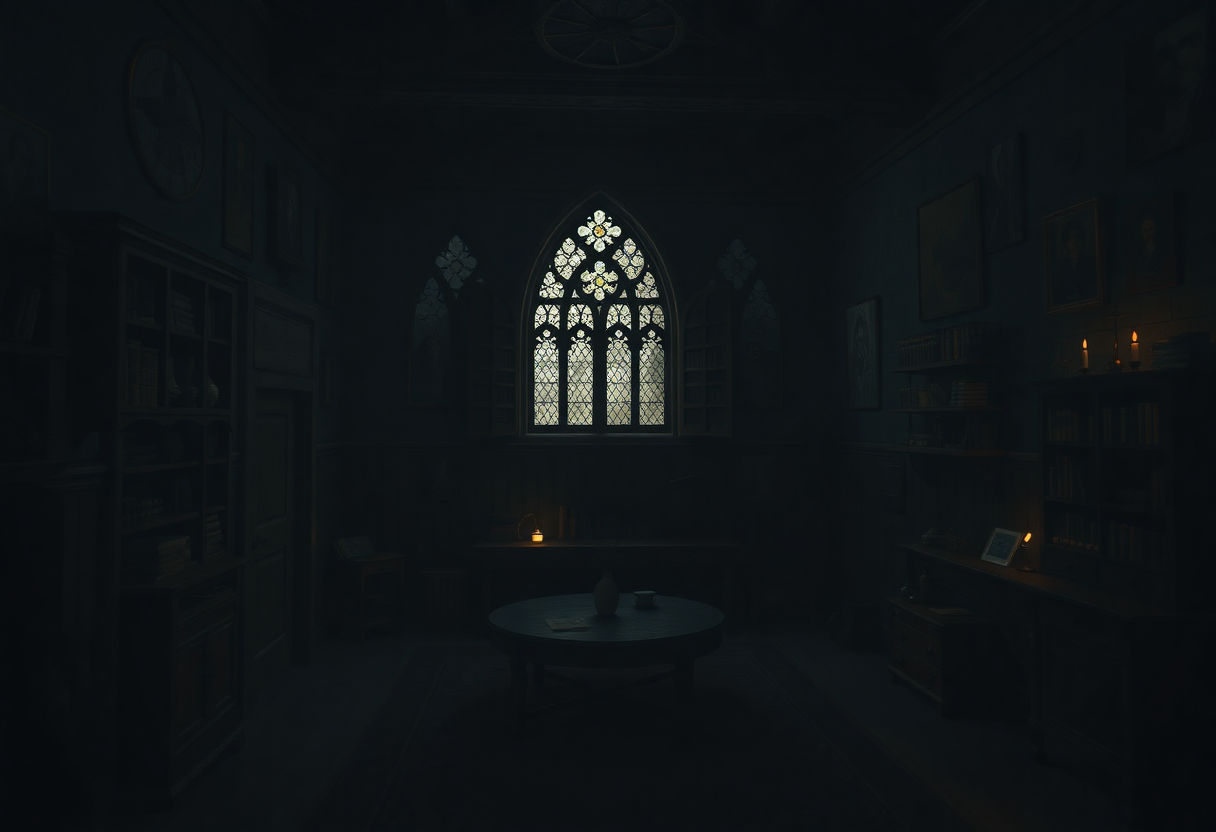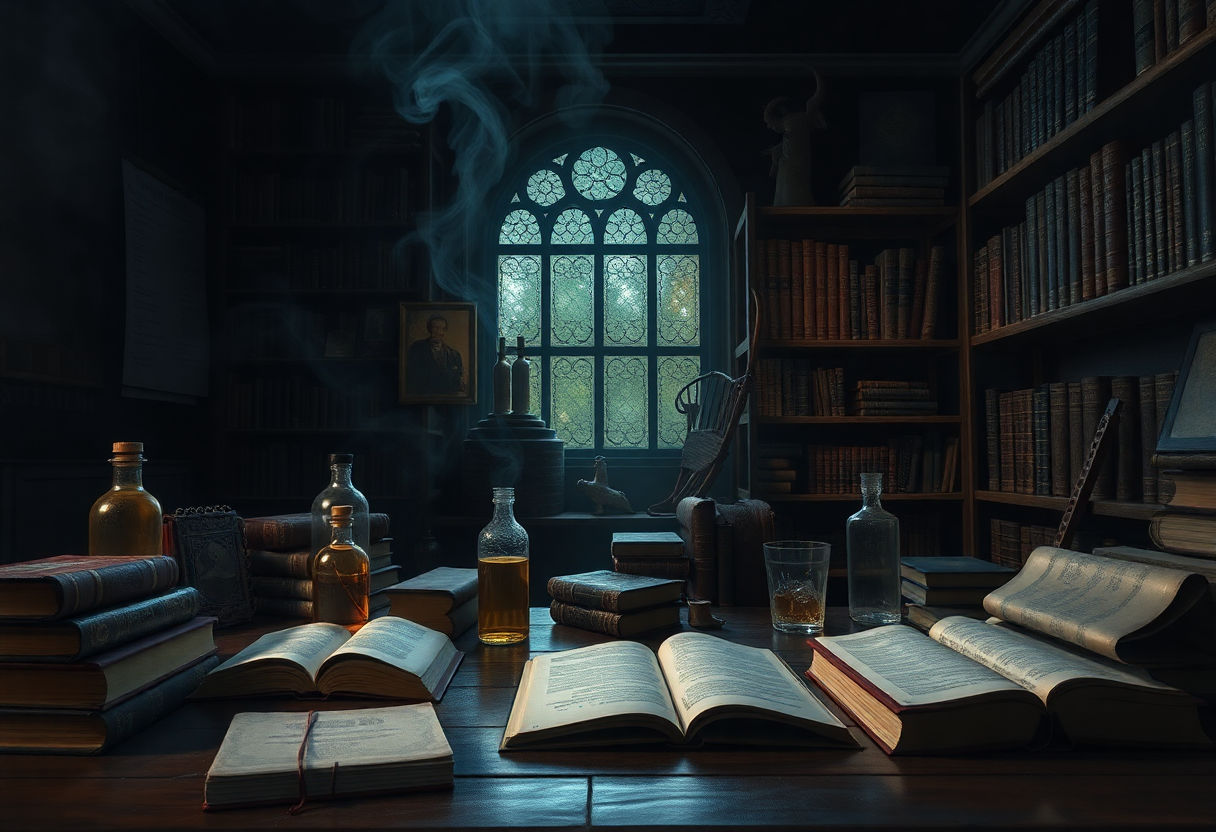The dark academia aesthetic, characterized by its moody, scholarly allure, finds a rich expression in J.K. Rowling’s Half-Blood Prince. This unique blend of classic literature, gothic architecture, and the relentless pursuit of knowledge has captured the imagination of readers and fans alike. As we delve into the roots of dark academia and its evocative presence throughout the narrative, we will explore how this theme manifests through character archetypes, symbolic settings, and sumptuous fashion. Join us as we unravel the intricate tapestry of romanticism and tragic beauty that makes Half-Blood Prince a quintessential representation of this captivating aesthetic.
Key Takeaways
- ‘Half-Blood Prince’ embodies the dark academia aesthetic through its intricate blend of knowledge, mystery, and gothic elements.
- The novel’s settings, such as Hogwarts and the Forbidden Forest, are quintessential representations of dark academia’s architectural fascination and atmospheric ambiance.
- Characters like Severus Snape and Albus Dumbledore epitomize the intellectual depth and tragic beauty central to the dark academia motif.
- The narrative’s emphasis on ancient magic and forgotten history aligns closely with the genre’s appreciation for the pursuit of wisdom.
- Costumes and fashion in ‘Half-Blood Prince’ subtly reflect the somber and scholarly aesthetic intrinsic to dark academia.
The Roots of Dark Academia

The dark academia aesthetic draws its profound inspiration from the interplay of history, culture, and education. This aesthetic reveres the romanticism of classical education, emphasizing an attachment to literature, arts, and a yearning for ancient knowledge.
The origins of dark academia can be traced to the intellectual movements of the past, notably the Renaissance and the Enlightenment. These eras sparked a resurgence of interest in classical scholarship, humanism, and the aesthetic beauty of learning itself. The grandeur of historic European universities mirrors this sentiment, with their gothic architecture and storied libraries becoming emblematic of the dark academia style.
Culturally, dark academia is heavily influenced by the literary works of the Romantic and Victorian periods. Authors like Oscar Wilde, Mary Shelley, and the Brontë sisters provide a rich tapestry of themes such as existential musings, moral complexities, and a fascination with the occult. These narratives often explore the dichotomy between nature and nurture, knowledge and ignorance, which are central to the dark academia world.
On a more modern note, the aesthetic has been popularized through films and literature that depict academic life as shrouded in mystery and intellect. These portrayals often highlight a fixation on esoteric studies, secret societies, and a brooding quest for wisdom.
Understanding the roots of dark academia is essential to fully appreciate its appearance in contemporary narratives, such as ‘Half-Blood Prince’, where these historical and cultural motifs eloquently intertwine, enriching the narrative with layers of depth and intrigue.
‘Half-Blood Prince’ as a Dark Academia Narrative

The narrative of Half-Blood Prince seamlessly intertwines with the dark academia aesthetic through its intricate themes and brooding tone. The storyline delves into the complexities of knowledge, power, and morality, echoing the quintessential essence of dark academia. The book is steeped in themes of mystery and intrigue, particularly through the uncovering of Voldemort’s past and the secrets kept within the walls of Hogwarts.
The narrative structure employs elements of a classic Gothic novel, with forbidding atmospheres and a pervasive sense of fatalism. The characters grapple with internal conflicts, embodying the dark academia emphasis on introspection and .existential questioning. Dumbledore and Snape, in particular, represent the duality of wisdom and shadow, often confronting moral ambiguity and ethical dilemmas.
Furthermore, the narrative explores the notion of forbidden knowledge. Harry’s interaction with the Half-Blood Prince’s potion book introduces him to a darker, more dangerous form of magic. This pursuit of knowledge at any cost highlights the seductive yet perilous nature of learning, a central theme of dark academia.
The emotional depth and poignant relationships depicted in Half-Blood Prince further align with the aesthetic. Harry’s experiences with love, loss, and loyalty are deeply moving and underscore the narrative’s romantic yet tragic dimensions. Through these elements, the book crafts a narrative that not only tells a story but also evokes the haunting beauty and reflective essence that characterizes dark academia.
Character Archetypes and Symbolism

In ‘Half-Blood Prince’, the presence of character archetypes and symbolism richly contributes to the dark academia aesthetic. Central to this theme are the characters who embody both classical archetypes and complex psychological profiles. Severus Snape stands as the quintessential anti-hero, a deeply flawed character whose internal conflict and tragic past resonate with dark academia’s fascination with the complexities of the human mind. His dual role as a protector and potential adversary exemplifies the blurred lines between good and evil—a key element of this aesthetic.
Tom Riddle, later known as Voldemort, is portrayed as the classic tragic villain. His backstory is one of ambition overtaking morality, a theme resonant with the perilous pursuit of forbidden knowledge. Riddle’s descent into darkness symbolizes the potential consequences of unchecked intellectual curiosity and power.
Moreover, Albus Dumbledore embodies the sage archetype. His wisdom and intellectual prowess, paired with an enigmatic demeanor, reflect the scholarly pursuit associated with dark academia. His death profoundly marks the narrative, symbolizing the inevitable decline of wisdom in the face of burgeoning darkness.
Throughout the book, symbolism is intricately woven to support these character arcs. The Half-Blood Prince’s potions book, riddled with annotations, becomes a symbol of hidden knowledge and the dangers it entails. Similarly, the locket Horcrux represents the depths of human ambition and the sacrifices made to control destiny.
Together, these characters and symbols intricately present ‘Half-Blood Prince’ as a narrative deeply embedded in the dark academia aesthetic, resonating with themes of knowledge, morality, and the eternal conflict between light and dark.
Key Settings in ‘Half-Blood Prince’

The sixth installment in the beloved Harry Potter series, Half-Blood Prince, offers a compelling array of settings that embody the dark academia aesthetic. The Hogwarts Castle itself is perhaps the most iconic, radiating an aura of scholarly mystery with its ancient architecture, hidden passages, and vast libraries. The castle serves as both a sanctuary for learning and a backdrop for the unfolding drama, with its candle-lit corridors and echoing halls enhancing the narrative’s somber, intellectual ambiance.
Another pivotal setting is the Potions Classroom, where Professor Snape imparts his knowledge of complex brews amidst an environment filled with dark wood, bubbling cauldrons, and a pervasive sense of foreboding. This setting underscores the thematic elements of experimentation and discovery that are quintessential to dark academia.
The Pensieve Room, where pivotal memories are revisited, provides a reflective, almost melancholic space, amplifying the theme of seeking knowledge at any cost. The swirling silvery substance within the Pensieve evokes an ethereal quality, inviting deeper contemplation—a hallmark of the genre.
Hogsmeade Village offers a respite with its cobblestone streets and quaint, historic ambiance. Despite its charm, there is an underlying tension as darkness seeps into even the most ordinary aspects of life, highlighting the precarious balance between the pursuit of joy and the impending danger.
Each of these settings not only serves as a backdrop for the narrative but also enriches its dark academia essence by juxtaposing the pursuit of knowledge with elements of mystery and the arcane. These locations collectively forge a vivid tapestry where scholarly endeavors and darker undertones intertwine seamlessly.
Theatrical Themes and Gothic Influence
The allure of the dark academia aesthetic within Half-Blood Prince can be significantly attributed to the theatrical themes and gothic influences permeating the story. These elements craft a refined, yet haunting ambiance, deeply resonating with readers.
The gothic influence primarily manifests through the quintessential setting of Hogwarts itself—a majestic castle steeped in centuries-old traditions, secret passageways, and eerie corridors. This backdrop serves as more than just a school; it symbolizes an ancient world full of arcane knowledge and hidden dangers. The looming threat of Voldemort casts a long shadow, enhancing the gothic atmosphere with elements of suspense and foreboding.
Theatricality is woven into the narrative through dramatic events that unfold with a sense of grandeur and inevitable tragedy. Dumbledore’s poignant dialogs and his ultimate demise infuse the story with an emotional gravitas reminiscent of classic theater. His tower, in particular, becomes the stage for one of the most climactic and emotionally charged scenes, evoking a palpable sense of loss and heroism.
The story also incorporates gothic motifs, such as the recurring theme of death and the supernatural. The Half-Blood Prince’s Potion book, with its cryptic annotations, acts as a relic of dark wisdom, blending mystery with a tangible gothic vestige. Additionally, the Pensieve, a vessel for exploring past memories, symbolizes the deep and often disturbing introspection characteristic of dark academia.
These theatrical and gothic elements elevate Half-Blood Prince beyond a simple narrative, transforming it into a rich tapestry that embodies the essence of dark academia.
The Role of Knowledge and Wisdom
In “Half-Blood Prince,” the pursuit of knowledge and wisdom emerges as a central theme aligning closely with the dark academia aesthetic. The narrative delves deeply into the intellectual endeavors of its characters, emphasizing the power and peril of knowledge.
Tom Riddle’s Quest for Immortality: At the heart of the story is Tom Riddle’s relentless pursuit of eternal life, which reveals the darker side of academia. His insatiable quest for forbidden knowledge in the form of Horcruxes showcases how wisdom can become a dangerous obsession.
Dumbledore’s Guidance: Contrastingly, Albus Dumbledore embodies the balance between wisdom and morality. His role as a mentor to Harry Potter underlines the notion of guided inquiry and ethical responsibility. Through their Pensieve sessions, Dumbledore imparts crucial insights, reinforcing that wisdom is not merely about acquiring knowledge, but understanding how to apply it ethically.
The Half-Blood Prince’s Influence: The mysterious potions book belonging to the Half-Blood Prince serves as a symbol of hidden knowledge. While it offers Harry unprecedented success in Potions class, it also underscores the unpredictability and risks inherent in blindly following unvetted sources.
Academic Settings: Hogwarts itself stands as a bastion of learning, its ancient corridors and libraries echoing with the weight of accumulated knowledge. These settings capture the quintessential dark academia atmosphere, where the pursuit of learning intertwines with the gothic and mysterious.
Overall, “Half-Blood Prince” skillfully explores the dual nature of knowledge, as both an empowering and potentially hazardous force, within its richly woven narrative.
Costumes and Fashion Symbolism

Fashion in ‘Half-Blood Prince’ plays a pivotal role in bringing the dark academia aesthetic to life. The characters’ attire subtly underscores their personalities and the intellectual aura pervasive in the narrative. The students’ uniforms at Hogwarts, with their muted colors and classic cuts, embody the quintessential dark academia style, emphasizing a blend of elegance and nostalgia. These uniforms symbolize discipline and tradition, core elements of the dark academia ethos.
Particularly noteworthy is the character of Severus Snape, whose attire—often dark, flowing robes—accentuates his mysterious and complex nature. This choice of wardrobe not only reflects his enigmatic persona but also echoes the gothic and scholarly facets of dark academia. His fashion serves as a constant reminder of his dual role as both protector and threat, adding layers to his character and to the story’s overall aesthetic.
Furthermore, Hermione Granger’s style evolution throughout the series illustrates her growing maturity and intellectual prowess. While maintaining elements of simplicity, her choice of sweaters and skirts in earthy tones reflects her practical yet scholarly disposition, aligning with the understated sophistication of dark academia.
The fashion choices in ‘Half-Blood Prince’ are not mere visual elements; they are laden with symbolic meaning. They highlight various psychological and thematic undercurrents, such as the tension between tradition and modernity and the quest for knowledge. These sartorial themes serve not just as a backdrop but as a narrative thread that weaves through the storyline, reinforcing the overarching aesthetic and enriching the reader’s experience.
Romanticism and Tragic Beauty
In “Half-Blood Prince,” the intertwining of romanticism and tragic beauty profoundly enhances the narrative, aligning seamlessly with the dark academia aesthetic. Romanticism in this context is manifested through the intense emotions, the profundity of character relationships, and the exploration of existential themes that Jordan embrace.
One prominent embodiment of this duality is Severus Snape. His character serves as the epitome of tragic beauty, where his deep, unreciprocated love for Lily Potter resonates throughout the storyline. This element of romanticism is darkened by the perennial sorrow and regret he carries, lending a melancholic beauty to his narrative arc. As Dumbledore observes, “Do not pity the dead, Harry. Pity the living, and above all, those who live without love.”
The nuanced relationship between Draco Malfoy and the burden of his family’s dark legacy further exemplifies the tragic beauty theme. Draco’s struggle to reconcile his own desires with the heavy expectations thrust upon him adds a romantic layer of internal conflict, evocative of the tumultuous human experience glorified in romantic literature.
Additionally, the setting of Hogwarts itself manifests romanticism through its gothic architecture and atmospheric charm. These elements collectively evoke a sense of nostalgia and the ephemeral beauty of moments shared in the historical and intellectual sanctity of its halls.
In these ways, romanticism and tragedy converge to offer a poignant exploration of beauty intertwined with sorrow, enriching the dark academia allure of “Half-Blood Prince” through emotional depth and aesthetic resonance.
Conclusion
In “Half-Blood Prince,” the dark academia aesthetic is masterfully encapsulated through its evocative settings, complex characters, and underlying themes of knowledge and wisdom. The blend of romanticism and tragic beauty offers a rich tapestry that speaks to the emotive and intellectual pursuits central to dark academia. This narrative not only enriches our understanding of the aesthetic but also invites future exploration into how such themes can be further integrated into literature and media. Embrace the allure of this aesthetic, allowing it to inspire deeper reflection and appreciation of intellectual pursuits within your own journey.
Frequently Asked Questions
What is the dark academia aesthetic and how does it relate to ‘Half-Blood Prince’?
The dark academia aesthetic is characterized by a love for classical literature, a fascination with knowledge, and a gothic visual style. In ‘Half-Blood Prince,’ this is reflected through the somber setting of Hogwarts, the characters’ quest for deeper understanding, and the melancholic atmosphere.
How are Hogwarts settings used to emphasize the dark academia aesthetic in ‘Half-Blood Prince’?
Hogwarts’ ancient architecture, dimly lit corridors, and the old library serve as quintessential elements that embody the dark academia aesthetic. These settings enhance the mysterious and intellectual aura that pervades the narrative.
Which characters from ‘Half-Blood Prince’ best represent dark academia themes?
Characters like Severus Snape and Albus Dumbledore exemplify dark academia with their deep intellect, complex personalities, and tragic backstories. Their narratives intertwine with themes of knowledge and the burden of wisdom.
Are there specific symbols in ‘Half-Blood Prince’ that highlight the dark academia feel?
Yes, symbols like the Half-Blood Prince’s textbook, which is filled with annotated potions and spells, emphasize the value of hidden knowledge and the personal pursuit of learning, key elements of the dark academia aesthetic.
Does the fashion in ‘Half-Blood Prince’ reflect the dark academia style?
The robes and traditional wizarding attire in ‘Half-Blood Prince’ mirror the dark academia fashion through their classic and timeless designs. These costumes play a vital role in visually representing the aesthetic’s emphasis on heritage and scholarliness.



